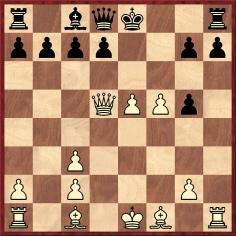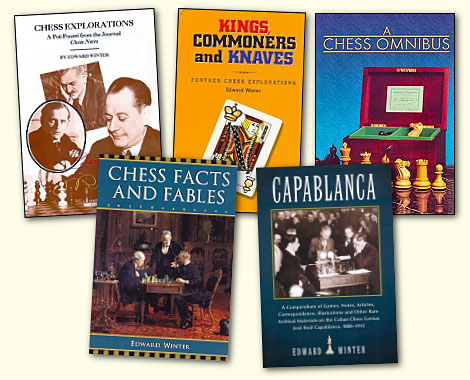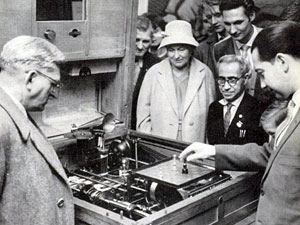Chess Explorations (98)
By Edward Winter
In this position, given in C.N. 2234, White played ‘undoubtedly the most
brilliant move ever made by a computer’:

The game was between the Moscow Institute and Stanford University, and
the remark was from Leonard Barden on page 187 of the June 1967 Chess
Review. The move in question was 15 Rxh7, and at the end of the same
page J.S. Battell added:
‘We don’t know what brilliant moves may have been made by computers previously;
but, in this game, the Moscow machine looms like a Morphy against a Duke
of Brunswick and a Count Isouard. We do expect, however, that the future
World Champion who takes on a computer will have a referee so stationed
as to ensure against there being a Schlumberger behind the machine’s moves!’
An older quote which also mentioned Morphy was reproduced in C.N. 2646.
Harry Golombek wrote on pages 8-9 of the January 1952 BCM:
‘My more mechanically minded readers will be interested to learn that
a portable electronic brain, weighing a mere 500 pounds and costing only
80,000 dollars, has been developed by the Computer Research Corporation
of Hawthorne, California. One of its designers, Richard Sprague, claims
it can play unbeatable chess. Donald H. Jacobs, president of the Jacobs
Instrument Company of Bethesda, Maryland, and himself developer of a 140-pound
mechanical brain, proved sceptical and challenged the CRC-102 (the euphonious
and imaginative name of the electronic midget brain) to a best of 20 games
match, offering to bet 1,000 dollars on his ability to defeat the baby
electronic brain without consulting his own mechanical brain for assistance.
The CRC-102 declined the match hastily on the grounds that the “urgency
for this machine in the defence effort makes such a tournament untimely”.
Clearly history is engaged in its habitual process of repeating itself
and we are faced once again with the Morphy-Staunton incident.’
C.N. 7536 gave this observation from page 357 of the December 1949 Chess
Review:
‘The claim is made that it is now possible to solve two-move chess problems
automatically by means of an electronic calculating machine. Even if this
device portends the invention of a monster that can play a whole game,
the world of human chess, it is safe to predict, will stick resolutely
to its time-honored methods of enjoying the royal game. It is fascinating,
however, to speculate on whether a machine could ever defeat a Botvinnik
and outstrip Ambrose Bierce’s fantastic thriller Moxon’s Master.’
And from the previous decade (quoted in C.N. 4581):
‘This week, in Chicago, a robot, controlled by a photo-electric cell,
will take on all comers at chess. The presumptuous creation is even offering
$150 to anyone who can outwit his moves engendered by the electric-eye
principle. O ye spirits of the great and ye living masters. Evans and
Steinitz, Euwe and Alekhine. Gang up mercilessly on this soulless monster,
split the profits and, most of all, re-establish the dignity of the human
mind.’
That call to arms appeared in the Chicago Daily News and was cited
on page 109 of the September-October 1938 American Chess Bulletin.
As regards predictions about the likely progress in computers’
strength, in C.N. 3846 Jonathan Hinton (East Horsley, England) drew attention
to a passage by P.H. Clarke in his ‘From the USSR’ column on pages 117-118
of the April 1963 BCM:
‘Chess in 2000
Will the world champion in 2000 be a man or a machine? This was the subject
for discussion on Moscow television recently by grandmasters Smyslov,
Bronstein and Averbakh. As might be expected, no agreement was reached.
Averbakh held that in about 35 years’ time scientists will be able to
design a machine perfect enough to compete with masters and even grandmasters
and that it will have many advantages over man. Smyslov was of a different
opinion. He compared chess with music, asserting that just as a mechanical
composer could not rival human fantasy, so a machine could not play better
chess than a man.
Bronstein took a middle line, surmizing that by the year 2000 there would
be separate championships for men and machines. I wonder who will be right.’
From page 345 of The Personality of Chess by I.A. Horowitz and
P.L. Rothenberg (New York, 1963) the following was quoted in C.N. 4126:
‘That a richly endowed robot will one day be able to play a highly skillful
game of chess leaves no room for doubt. On the other hand, in the absence
of a fantastic superspeed electronic brain, the chess championship of
the world is likely to be retained by humans for centuries to come.’
As reported in C.N. 1802, in 1989 Kasparov offered some comments on chess
computers in an interview with Thierry Paunin on pages 4-5 of issue 55 of
Jeux & Stratégie (our translation from the French):
‘Question: ... Two top grandmasters have gone down to chess
computers: Portisch against “Leonardo” and Larsen against “Deep Thought”.
It is well known that you have strong views on this subject. Will a computer
be world champion, one day ...?
Kasparov: Ridiculous! A machine will always remain a machine, that is
to say a tool to help the player work and prepare. Never shall I be beaten
by a machine! Never will a program be invented which surpasses human intelligence.
And when I say intelligence, I also mean intuition and imagination. Can
you see a machine writing a novel or poetry? Better still, can you imagine
a machine conducting this interview instead of you? With me replying to
its questions?’
Various C.N. items have discussed the faltering early
steps of chess computers. In C.N. 4470 Nathan Bauman (Seoul, South Korea)
wrote:
‘Regarding the first chess computer, a king and rook versus king problem-solving
machine invented by Leonardo Torres y Quevedo (1852-1936), I would draw
your attention to a recent article
I have written, “A New Photograph of ‘El jugador ajedrecista’, the World’s
First Chess Computer”.
I wonder whether any other pictures or clips can be found. There is
very little visual material available on the Internet, and what does exist
seems to have been conflated with a machine invented by Torres y Quevedo
some years later.’
In the same item we commented that some illustrations of Torres’ invention
(a photograph and four diagrams) appeared on pages 227-229 of Chess:
Man vs Machine by B. Ewart (London, 1980) and that although Ewart noted
that Torres’ machine (‘the first purely mechanical chess player’) was introduced
to the public at the Sorbonne in Paris in November 1915, a number of chess
computer books give the date of its invention as 1890. See, for example,
page 11 of Computer Chess by L. Pachman and V.I. Kühnmund (London,
1986) and page 20 of I giocatori artificiali by P. Ciancarini (Mursia,
1992).
Concerning the subsequent generation (in terms of both computers and the
Torres family), below is an item from page 94 of the February 1951 CHESS:

On the question of why a number of computer chess books affirm that Leonardo
Torres y Quevedo invented his chess computer as early as 1890, rather than
in 1912-14, C.N. 4525 reported that the earliest claim about 1890 known
to us was on page 286 of Faster Than Thought edited by B.V. Bowden
(London, 1953):
‘In about 1890 Signor Torres Quevedo made a simple machine – a real machine
this time – which with a rook and king can checkmate an opponent with
a single king.’
We commented that the Italianization did not inspire confidence, and that
no source for the information was offered. An ‘apparently’ quote from page
9 of The Machine Plays Chess? by Alex G. Bell (Oxford, 1978) was
also given:
‘Torres apparently built a prototype machine about 1890 which went through
a number of sporadic refinements. His final version made its most publicized
performance at the Paris World Fair in 1914 but it, understandably, sank
into oblivion on the outbreak of World War I. So much for the discrepancy
in dates.’
On the issue of when 1890 started to be mentioned in chess books as the
year in which Leonardo Torres y Quevedo invented his chess computer, C.N.
4547 mentioned that a relatively early instance was on page 13 of Chess
and Computers by David Levy (London, 1976), whereas page 3 of the same
writer’s Computer Chess Compendium (London, 1988) gave only 1914.
In C.N. 4482 Christian Sánchez (Rosario, Argentina) wrote:
‘On the Internet I have found two reliable Spanish sources for information
about the chess machines. One is a webpage of the Torres Quevedo Museum,
where the two prototypes are preserved; there are pictures of both Ajedrecista
machines. The other is an article by González Redondo; it has some illustrations
of the first Ajedrecista and allows a chronology of the inventions to
be drawn up:
1912: Leonardo Torres Quevedo began construction of the first Ajedrecista.
1914: The first Ajedrecista was exhibited in Paris.
1920: The second Ajedrecista was built by Gonzalo Torres Quevedo, under
his father’s direction.
1922: The second Ajedrecista was exhibited in Paris.’
In the same item Calle Erlandsson (Lund, Sweden) pointed out that in 1955
Spain issued a postage stamp depicting the inventor:

In C.N. 4495 Leonard Barden observed that Torres’ invention was placed
on view during the 1960 Olympiad in Leipzig, and we gave the photograph
below, from page 253 of XIV. Schach-Olympiade Leipzig 1960, published
by Sportverlag Berlin:

See also plate 1 in The Machine Plays Chess? by Alex G. Bell (Oxford,
1978).
Our final citation comes from page 210 of Every Great Chess Player Was
Once A Beginner by B. Byfield and A. Orpin (Secaucus, 1974). It was
shown, without warranty, in C.N. 6363:

A book could certainly be written about computers’ analytical discoveries
in games past and present. Some old examples were given on pages 5-7 and
14 of A Chess
Omnibus.
All
ChessBase articles by Edward Winter

Edward Winter is the editor of Chess
Notes, which was founded in January 1982 as "a forum for aficionados
to discuss all matters relating to the Royal Pastime". Since then, 8,050 items have been published, and the series has resulted in four books
by Winter: Chess
Explorations (1996), Kings,
Commoners and Knaves (1999), A
Chess Omnibus (2003) and Chess
Facts and Fables (2006). He is also the author of a monograph on
Capablanca (1989). In 2011 a paperback
edition was issued.
Chess Notes is well known for its historical research, and anyone browsing
in its archives
will find a wealth of unknown games, accounts of historical mysteries, quotes
and quips, and other material of every kind imaginable. Correspondents from
around the world contribute items, and they include not only "ordinary readers"
but also some eminent historians – and, indeed, some eminent masters. Chess
Notes is located at the Chess
History Center. Signed copies of Edward Winter's publications
are currently
available.





























